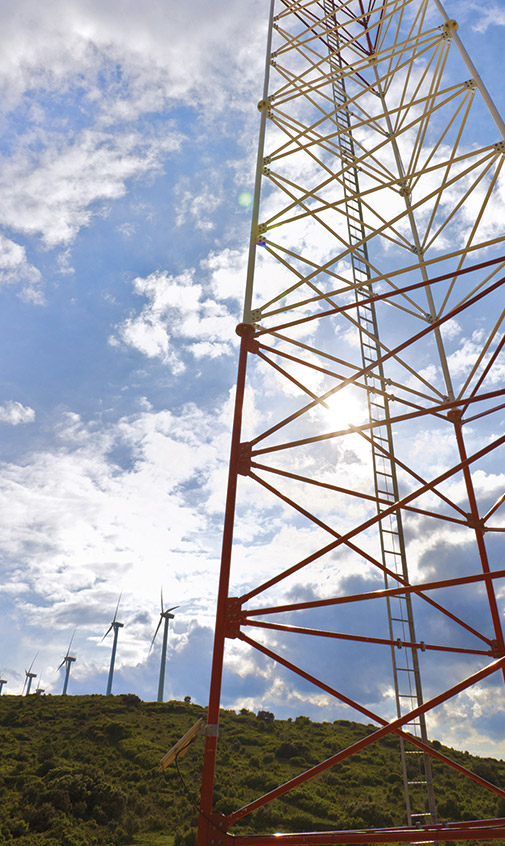Wind energy: how is wind measured?
In this article we explain the principles that govern wind measurement and its origins in history. We will focus on wind measurement towers, both braced towers and self-supported wind measurement towers.
You might be surprised to read that wind energy began to be used in the year 4500 B.C. In Ancient Egypt, the force of the wind was already used to sail the Nile River. Thousands of years later, the first mills for irrigation and grinding appeared.
This is how wind became one of the first meteorological variables that humans tried to measure historically. But how is wind measured exactly? Is there more than one system? What are measuring towers? What differentiates a braced wind tower from a self-supported tower?
What unit is used to measure wind?
‘Wind’ is the word we use to refer to air that moves horizontally. Unlike temperature, humidity or pressure measurement, wind is a vector magnitude and therefore it requires two different measurements.
To measure wind, two complementary parameters are used: speed and direction. The measures we use to measure these parameters are very different.
The measurement units we use to measure and express the speed of wind are kilometer per hour (km/h) or meter per second (m/s). The intensity or speed of wind can be measured by using an anemometer. The Beaufort Wind Scale allows a classification of wind according to its intensity on a scale from 0 to 12.
On the other hand, the direction of wind is determined with a weather vane.
What is a wind measurement tower?
A wind measurement tower is a metallic structure that is braced at different heights. These types of towers are formed by metal or steel support structures to which the necessary equipment is installed according to the final function that they are going to fulfill.
Wind measurement towers are designed, as their name indicates, to masure wind. The installation of a wind measurement tower is quick and safe, with no cranes or concrete needed.
Thanks to the quality of our structures, both in braced towers and self-supported towers, TV95 is a benchmark in the wind measurement sector at an international level.
We install towers at any height and in any location directly with our team of expert installers and engineers. We also take care of any necessary maintenance and repairs after the installation has taken place.
Do you need to train your installers? At TV95 Premier we offer training to our installer clients so that together we can get the most out of our products.

Height of TV95 Premier’s wind towers
Over the years, at TV95 Premier we have been breaking the height record for our braced wind measurement towers. We do it with the aim of being able to adapt to the needs of new wind projects.
At present, this type of installation requires greater height, reliability and precision, and for this reason we offer you the most suitable products and systems in each case.
We have installed wind measurement towers on all continents and in the most varied locations. We continuosly surpass ourselves, going from a maximum height of 145 meters in 2006 to reaching a height of 180 meters nowadays, both in braced towers and in self-supporting wind towers.
What are the benefits of wind measurement
Constantly measuring the wind in certain regions can be highly beneficial. Studying daily metrics and analyzing any unexpected changes can help detect risk situations.
This would allow the population to be alerted before extreme conditions arrive so that they can take action and seek shelter if necessary, as has happened on previous occasions.
In order to monitor the wind on a large scale, as it happens in wind stations, it is necessary to install wind measurement towers.
How to measure wind at home
The anemometer is the most popular device for measuring wind speed. It can be supplemented with a weather vane, which helps determine the direction of the wind.
You can find affordable devices and use them in your own home. In fact, you can even find a device which connects to a weather station directly.
This allows you to collect information to view statistics and make comparisons, establish weather forecasts or access all data remotely. Beyond this, having connected devices will not really improve their accuracy or reliability. When measurements are made on a large scale, for example, for wind stations, the presence of wind measurement towers is necessary to ensure a correct measurement.
Guyed tower VS self-supported tower
Braced towers are armed with metal or steel angle trusses and the joints are welded. It is installed in locations with strong winds due to its great resistance, supporting winds of up to 150 km/h. They are used for the installation of a large number of antennas or other devices.
The self-supporting towers have the shape of a tubular triangular pyramid. They are self-supporting metal structures that, despite their flexibility, are not so resistant to the action of the wind. They are installed in places where there is little space available.
At TV95 Premier we have built and installed towers that exceed 180 meters, both in braced and self-supported towers.

